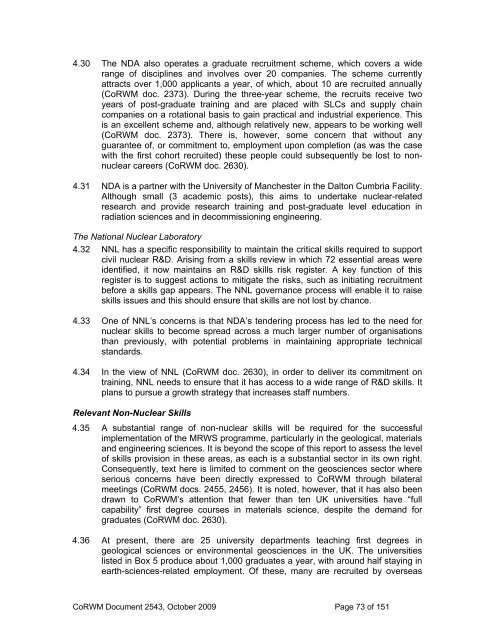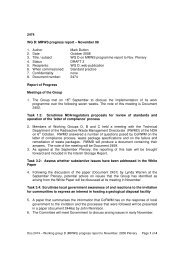2009 Report to Government on National Research and
2009 Report to Government on National Research and
2009 Report to Government on National Research and
- TAGS
- corwm.decc.gov.uk
You also want an ePaper? Increase the reach of your titles
YUMPU automatically turns print PDFs into web optimized ePapers that Google loves.
4.30 The NDA also operates a graduate recruitment scheme, which covers a wide<br />
range of disciplines <strong>and</strong> involves over 20 companies. The scheme currently<br />
attracts over 1,000 applicants a year, of which, about 10 are recruited annually<br />
(CoRWM doc. 2373). During the three-year scheme, the recruits receive two<br />
years of post-graduate training <strong>and</strong> are placed with SLCs <strong>and</strong> supply chain<br />
companies <strong>on</strong> a rotati<strong>on</strong>al basis <str<strong>on</strong>g>to</str<strong>on</strong>g> gain practical <strong>and</strong> industrial experience. This<br />
is an excellent scheme <strong>and</strong>, although relatively new, appears <str<strong>on</strong>g>to</str<strong>on</strong>g> be working well<br />
(CoRWM doc. 2373). There is, however, some c<strong>on</strong>cern that without any<br />
guarantee of, or commitment <str<strong>on</strong>g>to</str<strong>on</strong>g>, employment up<strong>on</strong> completi<strong>on</strong> (as was the case<br />
with the first cohort recruited) these people could subsequently be lost <str<strong>on</strong>g>to</str<strong>on</strong>g> n<strong>on</strong>nuclear<br />
careers (CoRWM doc. 2630).<br />
4.31 NDA is a partner with the University of Manchester in the Dal<str<strong>on</strong>g>to</str<strong>on</strong>g>n Cumbria Facility.<br />
Although small (3 academic posts), this aims <str<strong>on</strong>g>to</str<strong>on</strong>g> undertake nuclear-related<br />
research <strong>and</strong> provide research training <strong>and</strong> post-graduate level educati<strong>on</strong> in<br />
radiati<strong>on</strong> sciences <strong>and</strong> in decommissi<strong>on</strong>ing engineering.<br />
The Nati<strong>on</strong>al Nuclear Labora<str<strong>on</strong>g>to</str<strong>on</strong>g>ry<br />
4.32 NNL has a specific resp<strong>on</strong>sibility <str<strong>on</strong>g>to</str<strong>on</strong>g> maintain the critical skills required <str<strong>on</strong>g>to</str<strong>on</strong>g> support<br />
civil nuclear R&D. Arising from a skills review in which 72 essential areas were<br />
identified, it now maintains an R&D skills risk register. A key functi<strong>on</strong> of this<br />
register is <str<strong>on</strong>g>to</str<strong>on</strong>g> suggest acti<strong>on</strong>s <str<strong>on</strong>g>to</str<strong>on</strong>g> mitigate the risks, such as initiating recruitment<br />
before a skills gap appears. The NNL governance process will enable it <str<strong>on</strong>g>to</str<strong>on</strong>g> raise<br />
skills issues <strong>and</strong> this should ensure that skills are not lost by chance.<br />
4.33 One of NNL’s c<strong>on</strong>cerns is that NDA’s tendering process has led <str<strong>on</strong>g>to</str<strong>on</strong>g> the need for<br />
nuclear skills <str<strong>on</strong>g>to</str<strong>on</strong>g> become spread across a much larger number of organisati<strong>on</strong>s<br />
than previously, with potential problems in maintaining appropriate technical<br />
st<strong>and</strong>ards.<br />
4.34 In the view of NNL (CoRWM doc. 2630), in order <str<strong>on</strong>g>to</str<strong>on</strong>g> deliver its commitment <strong>on</strong><br />
training, NNL needs <str<strong>on</strong>g>to</str<strong>on</strong>g> ensure that it has access <str<strong>on</strong>g>to</str<strong>on</strong>g> a wide range of R&D skills. It<br />
plans <str<strong>on</strong>g>to</str<strong>on</strong>g> pursue a growth strategy that increases staff numbers.<br />
Relevant N<strong>on</strong>-Nuclear Skills<br />
4.35 A substantial range of n<strong>on</strong>-nuclear skills will be required for the successful<br />
implementati<strong>on</strong> of the MRWS programme, particularly in the geological, materials<br />
<strong>and</strong> engineering sciences. It is bey<strong>on</strong>d the scope of this report <str<strong>on</strong>g>to</str<strong>on</strong>g> assess the level<br />
of skills provisi<strong>on</strong> in these areas, as each is a substantial sec<str<strong>on</strong>g>to</str<strong>on</strong>g>r in its own right.<br />
C<strong>on</strong>sequently, text here is limited <str<strong>on</strong>g>to</str<strong>on</strong>g> comment <strong>on</strong> the geosciences sec<str<strong>on</strong>g>to</str<strong>on</strong>g>r where<br />
serious c<strong>on</strong>cerns have been directly expressed <str<strong>on</strong>g>to</str<strong>on</strong>g> CoRWM through bilateral<br />
meetings (CoRWM docs. 2455, 2456). It is noted, however, that it has also been<br />
drawn <str<strong>on</strong>g>to</str<strong>on</strong>g> CoRWM’s attenti<strong>on</strong> that fewer than ten UK universities have “full<br />
capability” first degree courses in materials science, despite the dem<strong>and</strong> for<br />
graduates (CoRWM doc. 2630).<br />
4.36 At present, there are 25 university departments teaching first degrees in<br />
geological sciences or envir<strong>on</strong>mental geosciences in the UK. The universities<br />
listed in Box 5 produce about 1,000 graduates a year, with around half staying in<br />
earth-sciences-related employment. Of these, many are recruited by overseas<br />
CoRWM Document 2543, Oc<str<strong>on</strong>g>to</str<strong>on</strong>g>ber <str<strong>on</strong>g>2009</str<strong>on</strong>g> Page 73 of 151



